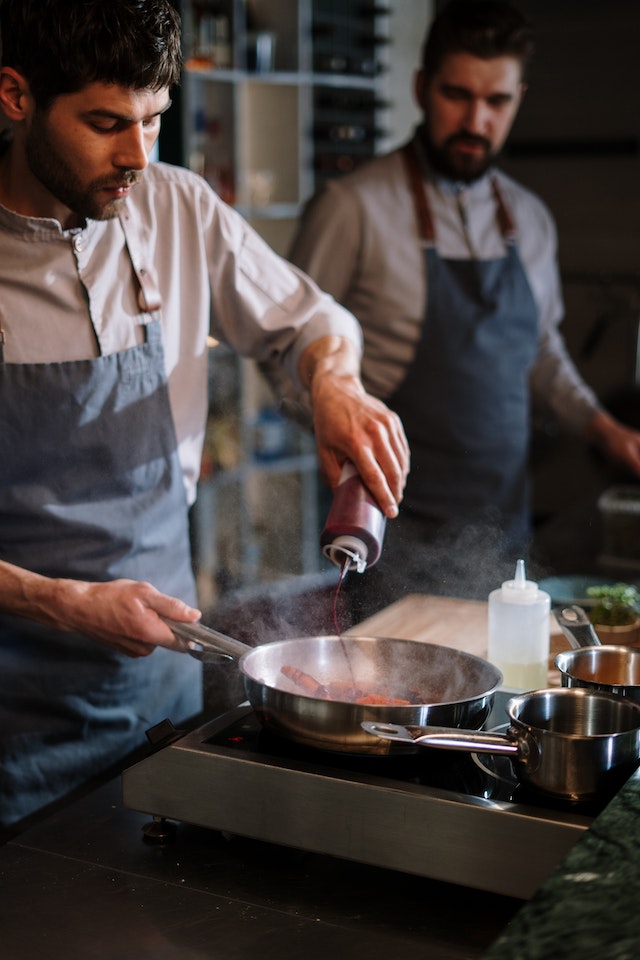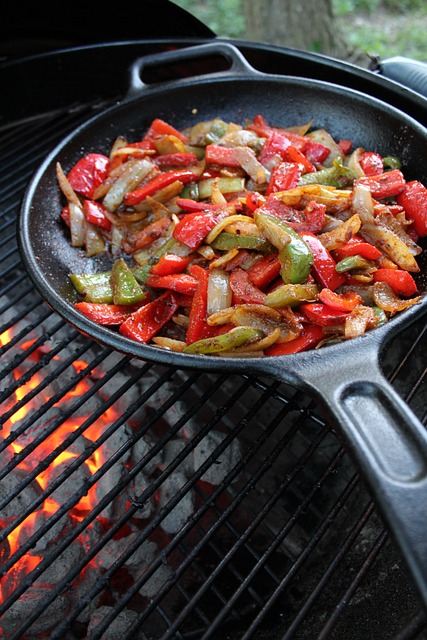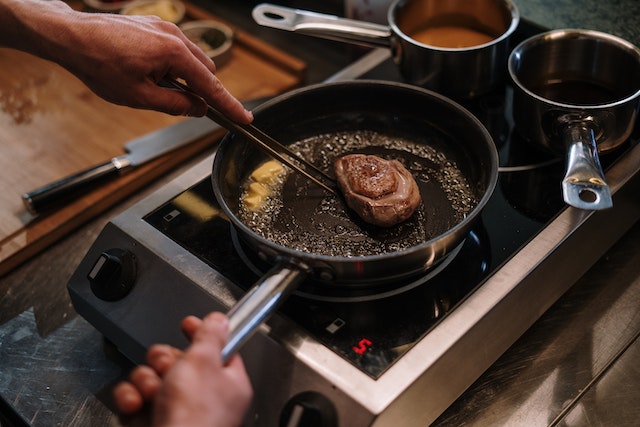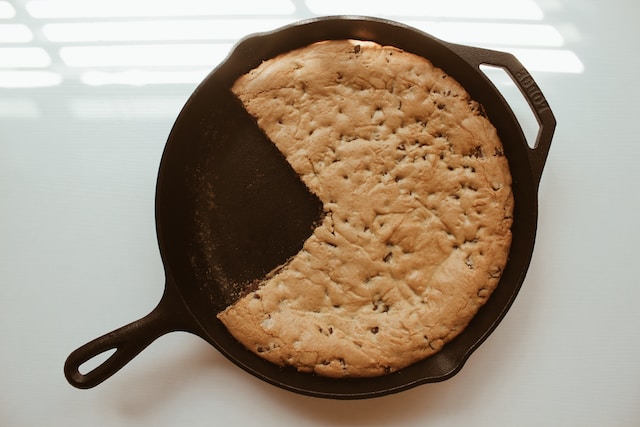
Skillets, those unassuming yet essential pieces of cookware, serve as the backbone of any well-equipped kitchen. With their flat, circular bottoms and high, slanted sides, skillets are versatile tools that can tackle a wide array of cooking tasks. From sautéing and frying to searing and simmering, skillets are indispensable companions for both professional chefs and home cooks alike.
The distinct design of skillets ensures even heat distribution, enabling chefs to achieve perfectly cooked dishes every time. The flat bottom comes into play when searing meats, creating a robust flavor and mouthwatering crust. Meanwhile, the high, sloping sides prevent ingredients from spilling over the edges while allowing for easy tossing and flipping. This dual functionality elevates skillets to a league of their own.
Traditionally crafted from durable materials like cast iron, stainless steel, or copper, skillets have stood the test of time. These materials not only retain heat, but they also develop a natural patina over time that enhances their nonstick properties. Modern skillets often feature nonstick coatings, making them a breeze to clean and ensuring that food effortlessly releases from the pan.
Skillets aren’t limited to any specific realm of cuisine; they seamlessly adapt to various cooking styles. Whether you’re whipping up a delicate French omelette, indulging in a hearty American breakfast, or embarking on a culinary adventure preparing Asian stir-fries, your trusty skillet will always have your back.
Moreover, skillets transcend the boundaries of stove cooking and are equally at home in the oven. This versatility allows for seamless transitions between stovetop searing and finishing off dishes in the oven. From crispy-skinned chicken to perfectly baked frittatas, your skillet’s capabilities are virtually limitless. This kitchen workhorse effortlessly combines function with finesse, adding depth and flavor to every dish.
Types of Skillets
When it comes to skillets, there is a wide range of options available to suit every cook’s needs and preferences. From traditional cast iron skillets to modern nonstick wonders, each type brings its distinct advantages to the culinary table. Here, we explore the different types of skillets, their features, and what makes them uniquely valuable:
Cast Iron Skillets
A true classic in the kitchen, cast iron skillets have been trusted companions for generations. The unparalleled heat retention and distribution properties of cast iron make these skillets perfect for searing, frying, and baking. Their heavy-duty construction ensures even cooking, while the natural nonstick surface that develops over time adds depth and flavor to your dishes. Cast iron skillets require proper care and maintenance, but the results they deliver are well worth the effort.
Stainless Steel Skillets
Durable and versatile, stainless steel skillets are a popular choice for many home cooks and professional chefs. With their sleek and modern appearance, stainless steel skillets offer excellent heat conductivity and retention. These skillets often feature an aluminum or copper core sandwiched between layers of stainless steel, providing even heat distribution and preventing hot spots. Stainless steel skillets are ideal for searing, sautéing, and deglazing, giving you the freedom to explore a wide range of cooking techniques.

Nonstick Skillets
For those seeking easy cleanup and effortless food release, nonstick skillets are the way to go. These skillets feature a special coating on their cooking surface, preventing food from sticking and making them a breeze to clean. Nonstick skillets are perfect for delicate foods like eggs, pancakes, and fish, where precise cooking control and easy flipping are essential. It is important to use nonmetallic utensils with these skillets to prevent scratching the nonstick coating.
Copper Skillets
Copper skillets are a chef’s delight, known for their outstanding heat conductivity and responsiveness. The exceptional thermal qualities of copper allow for precise temperature control, making these skillets ideal for tasks that require quick adjustments, such as sautéing and caramelizing. Copper skillets often feature a layer of stainless steel or tin to provide a safe cooking surface and prevent reactive interactions between copper and certain ingredients.
Ceramic Skillets
If you crave a non-toxic and eco-friendly option, ceramic skillets may be your best bet. Made from natural clay and minerals, these skillets offer excellent heat distribution and retention. The ceramic coating provides a nonstick surface without the need for chemicals, ensuring healthier cooking experiences. Ceramic skillets are great for low to medium heat cooking, allowing you to prepare delicious meals without compromising your health or the environment.
No matter which type of skillet you choose, adding this versatile cookware to your kitchen arsenal will elevate your culinary endeavors to new heights.
Skillet Cooking Techniques
Skillets are much more than just a tool for cooking; they are vessels that allow you to showcase your culinary skills and bring out the best flavors in your ingredients. Here, we explore a variety of skillet cooking techniques that will help you master the art of stove-top cooking.
- Searing: Achieving a perfect sear on meat or fish is a skill that every chef aspires to master. With a skillet, you can easily achieve that golden crust and juicy interior. Start by preheating your skillet until it reaches a smoking point. Season your protein of choice with salt and pepper, and then carefully place it in the hot skillet, pressing it down gently to ensure maximum contact with the pan. Let it sizzle and sear without moving it for a few minutes, until it develops a beautiful caramelized crust. Flip it over and repeat on the other side. The result? A mouthwatering dish with irresistible flavors and textures.

Sautéing: Sautéing is a versatile cooking technique that involves quickly cooking ingredients over high heat with a small amount of oil or butter. It’s perfect for vegetables, thinly sliced meats, and seafood. To achieve the perfect sauté, start by heating your skillet over medium-high heat. Once it’s hot, add a little oil or butter, and then add your ingredients. Make sure to keep them moving in the skillet using a spatula or a toss of the pan for even cooking. Sautéing allows ingredients to retain their natural flavors and textures while enhancing them with a rich caramelization.
- Stir-frying: Stir-frying is a high-heat cooking technique commonly used in Asian cuisine to quickly cook bite-sized pieces of food. It’s a fantastic way to retain the vibrant colors and fresh flavors of vegetables while creating a delicious, aromatic dish. Begin by preheating your skillet over medium-high heat until it’s smoking hot. Add a small amount of oil and then toss in your thinly sliced meat, vegetables, and any other desired ingredients. Keep stirring and tossing them rapidly to ensure even cooking. The goal is to achieve a crisp-tender texture without overcooking. Season your stir-fry with your choice of sauces, spices, and herbs, and serve it over steamed rice or noodles for a complete meal bursting with flavors.
- Braise and Simmer: Skillets are not limited to high-heat cooking techniques; they are also excellent for braising and simmering. These slow-cooking methods allow you to tenderize tougher cuts of meat and infuse them with rich flavors. Start by searing the meat in the skillet to develop a deep, caramelized crust. Then, add your liquid – whether it’s broth, wine, or a combination of both – along with aromatic ingredients such as onions, garlic, and herbs. Reduce the heat to low, cover the skillet, and let the magic happen. The low, slow cooking process will result in tender, melt-in-your-mouth meat that’s packed with flavor.
Skillet Recipes and Inspirations
Once you have your trusty skillet in hand, it’s time to embark on a culinary journey filled with delicious recipes and endless inspiration. From breakfast delights to gourmet feasts, your skillet will become your go-to tool for creating flavorful masterpieces. Here are some mouthwatering recipes and inspirations to get you started:
Breakfast Delights:
Fluffy Pancakes with Berries: Start your day off right with a stack of fluffy pancakes cooked to perfection in your skillet. Top them with fresh berries and a drizzle of maple syrup for a burst of sweetness.
Classic French Toast: Dip slices of bread into a rich egg mixture and cook them in your skillet until golden brown. Finish with a sprinkle of powdered sugar and a dollop of butter for an indulgent breakfast treat.
Comforting Lunches:
Grilled Cheese and Tomato Soup: The ultimate comfort food duo, a grilled cheese sandwich paired with warm tomato soup, takes on a whole new level of deliciousness when prepared in a skillet. The crispy bread and gooey cheese will satisfy any craving.
Skillet Pizza: Forget delivery and whip up a homemade pizza in your skillet. Cook the dough until crispy and then top with your favorite combination of cheese, sauce, and toppings. A quick trip to the oven will melt the cheese to perfection.
Flavorful Dinners:
Skillet Seared Steak with Garlic Butter: Achieve restaurant-quality steak by searing it in your skillet until it forms a crust. Add a pat of garlic butter on top and let it melt to add a heavenly touch of flavor.

One-Pan Chicken and Vegetable Stir-Fry: Combine marinated chicken, vibrant vegetables, and a flavorful sauce in your skillet for a quick and healthy dinner. The high heat will ensure everything cooks to perfection with a delightful char.
Ethnic Inspirations:
Skillet Paella: Transport yourself to the streets of Spain with a savory paella cooked in your skillet. Combine saffron-infused rice with shrimp, chicken, chorizo, and an assortment of vegetables for a vibrant and flavorful meal.
Skillet Pad Thai: Experience the flavors of Thailand with a homemade pad Thai cooked in your skillet. Toss noodles, shrimp, tofu, peanuts, and a tangy sauce together for a satisfying and authentic dish.
Sweet Desserts:
Skillet Apple Crisp: Sauté sliced apples with cinnamon and sugar in your skillet until they soften. Top with a crispy oat and brown sugar crumble and bake until golden brown. Serve with a scoop of vanilla ice cream for the perfect ending to any meal.
Skillet Chocolate Chip Cookie: Whip up a giant cookie in your skillet for a dessert that’s as impressive as it is delicious. The crispy edges and gooey center will have everyone coming back for seconds.

With these skillet recipes and inspirations, you’ll be able to explore the endless possibilities that your skillet has to offer.
Maintaining and Caring for Skillets
To ensure that your skillet continues to serve you faithfully for years to come, proper maintenance and care are essential. By following a few simple steps, you can keep your skillet in pristine condition and ready to create culinary wonders whenever inspiration strikes.
Seasoning Your Cast Iron Skillet
1. Preparing the Skillet: Before you embark on the seasoning process, make sure your cast iron skillet is clean and free of any debris. If it is a brand new skillet, wash it with warm water and mild soap, then dry it thoroughly.
2. Applying Oil: Coat the inside and outside of the skillet, including the handle, with a thin layer of vegetable oil or melted shortening. Avoid using butter or olive oil, as they have low smoke points, which can lead to a sticky residue.
3. Baking the Skillet: Place the skillet upside down in an oven preheated to 350 degrees Fahrenheit (175 degrees Celsius) and let it bake for one hour. This process helps the oil polymerize, creating a naturally nonstick surface.
4. Cooling and Storing: After the hour is up, turn off the oven and let the skillet cool completely inside. Once it has cooled, store the skillet in a dry place to prevent moisture from causing rust.
Cleaning Your Skillet:
- Immediate Cleaning: After each use, wash your skillet with a sponge, warm water, and a gentle dish soap. Avoid using abrasive brushes or scouring pads that can damage the seasoning.
- Removing Stubborn Residue: If food sticks to the skillet, fill it with warm water and allow it to soak for a few minutes. Then, use a nonabrasive brush or sponge to gently scrub away any remaining residue.

- Drying Properly: Thoroughly dry the skillet with a towel or by placing it on low heat on the stovetop until all moisture evaporates. Leaving the skillet wet can lead to rust formation.
- Applying a Thin Coat of Oil: After cleaning and drying, apply a light layer of oil to the skillet to maintain its seasoning. This will help prevent rust and maintain its nonstick properties.
Storing Your Skillet:
Stack with Care: If you need to stack your skillets to save space, place a paper towel or a cloth between them to prevent scratches and maintain their seasoning.
Hanging Options: Consider hanging your skillet on a pot rack or using a wall-mounted magnetic strip to keep it easily accessible and avoid the risk of damaging the seasoning by stacking.
Rejuvenating Your Skillet:
If your skillet develops any signs of rust, scrub the affected area with a nonabrasive brush or steel wool until the rust is completely removed. Rinse and dry the skillet thoroughly, then reseason it to restore its protective layer.
Over time, the seasoning on your skillet may start to wear off. To re-season it, follow the seasoning process described earlier, applying a light coat of oil and baking it in the oven. This will help maintain the nonstick surface and prevent further rusting.
By maintaining and caring for your skillet with these simple steps, you can enjoy its exceptional cooking performance for years to come. With proper seasoning, cleaning, and storage, your skillet will continue to be the reliable companion you need to create culinary masterpieces that will delight your taste buds and impress your guests.
